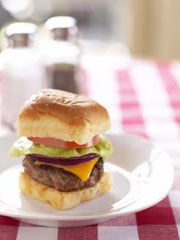This article was first published on Kenmore.com at http://inspiration.kenmore.com, where you’ll find more great ideas for cooking and entertaining.
So you have read part one and you’re definitely interested in participating in the Locavore Movement, but now you have a dilemma…how can you purchase locally grown foods that are also organic? The organic trend was developed as a solution to avoid pesticides, a major environmental health concern. It’s also thought that the method of growing organic products stresses the product in such a way that they develop higher levels of life-enhancing antioxidants. The most ideal solution would be to have an abundance of organically produced, locally grown foods, but unfortunately that is not always an option. When choosing between organic and local, it is most effective and socially responsible to pick local. By choosing products that have not traveled hundreds or thousands of miles, the food is allowed to ripen fully, is less susceptible to disease and is more eco-friendly. After all, the overall goal is to significantly reduce our carbon footprint to provide a healthier tomorrow.
Think about it: if a New Yorker wants to eat organics, they usually have to buy foods trucked from different parts of the country or even shipped by boat from Chile. That creates a huge carbon footprint in terms of transportation and fuel – and the travel time causes a loss of nutrients. Better to source foods that are “within a lazy day of driving,” as author Barbara Kingsolver writes in her book, Animal, Vegetable, Miracle: A Year of Food Life. In it, she describes how her family spent a year eating only homegrown and local food. Granted, she lives in southern Appalachia and is an accomplished gardener, but her book is a great overview of the Locavore philosophy.
http://harpercollins.com/books/Animal-Vegetable-Miracle/?isbn=9780060852559
In addition to helping reduce the total carbon footprint, those individuals choosing to participate in the Locavore movement are also helping small farmers and the local economy. Small farmers are able to offer a wider variety of produce to a more select audience. Instead of supplying a wholesaler with vast quantities of a single crop, the local farmer can offer an array of produce options in smaller, more easily managed quantities. He or she can test a new type of fruit or vegetable without risking acres and acres of crops. If you would like a guide to help you learn how to use the naturally grown resources provided to you by locally based small farmers, check out http://www.eatlocalchallenge.com/. This site has great tips and advice such as the article “10 reasons to eat local”.
Another way you can enjoy local produce and support sustainable agriculture in your own community is by finding a farm that participates in CSA (Community Supported Agriculture). With a CSA, you buy a “share” of the farmer’s crops for a season, and receive a weekly box of locally grown, seasonal produce right off the farm. Joining a CSA is a great opportunity to:
• Show your children where their food comes from
• Teach kids about seasonality
• Try new foods as many CSA’s provide recipes to go along with produce you might be unfamiliar with
• Encourage kids to learn how a farm works (most offer tours)
• Meet the farmer who grows your food
• And of course, enjoy super-fresh produce
For more information, check out http://www.localharvest.org/csa/
Teaching the younger generation healthy and sustainable habits can be easy and extremely effective. For example, teaching kids about seasonality can mean learning how to can and preserve foods, too. For instance, when peaches are in season (which they are at this moment), you can make peach preserves to enjoy during the winter. It’s another way to diversify your children’s diets and get them to choose healthy food options. Shop with them, search for recipes together. Involve them in the process and they’ll be healthier adults!
Want to read more about eating local? Check out these sources for information on finding natural foods and local pick-your-own farms.
http://pickyourown.org/ – Find a pick-your-own farm and learn how to can and freeze.
http://eatwild.com/ – A source for natural grass-fed meats, poultry and dairy products.
http://www.wisefoodways.com/ – Exploring food, creating community and eating at home.


; ?>/img/parties-that-cook-blog-logo.jpg)

